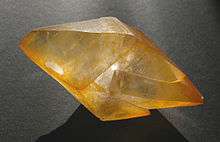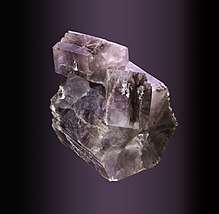Dimorphism (crystallography)
Dimorphism is the property of some minerals to exist in two different crystal systems, while still having the same chemical formula. A common example is calcium carbonate (CaCO3), which exists as trigonal calcite or orthorhombic aragonite in nature. A mineral's dimorph is the mineral that it is dimorphic with.[1][2] Dimorphism is not to be confused with allotropy, which refers to a difference in crystal structure of pure elements.

Doubly terminated calcite crystal.

Aragonite from Spain.
Trimorphism & Polymorphism
Trimorphism is the term used when a mineral has a total of three dimorphs,[3] while the term polymorphism is used when there are four or more. Silica, SiO2, is an example of this, being found in nature as quartz, tridymite, cristobalite, coesite, and stishovite.[4] Pleomorphism is a synonym of polymorphism.[4]
gollark: Why does the energy have a wavelength now?
gollark: It isn't a wording problem.
gollark: What? That's obviously impossible.
gollark: It's energy *per photon*. The power of each wavelength emitted varies according to that graph there.
gollark: Because when wavelength goes up energy goes *down*.
References
- "Definition of dimorphism - mindat.org glossary". www.mindat.org. Retrieved 2016-10-23.
- "Dimorphous - Minerals.net Glossary of Terms". www.minerals.net. Retrieved 2016-10-23.
- "Definition of trimorphism - mindat.org glossary". www.mindat.org. Retrieved 2016-10-23.
- "Definition of polymorphism - mindat.org glossary". www.mindat.org. Retrieved 2016-10-23.
This article is issued from Wikipedia. The text is licensed under Creative Commons - Attribution - Sharealike. Additional terms may apply for the media files.